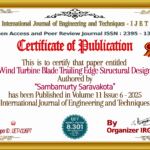
Study of Composite Laminate Behavior with different ply sequence under Biaxial loading | IJET – Volume 11 Issue 5 | IJET-V11I5P26

Table of Contents
ToggleInternational Journal of Engineering and Techniques (IJET)
Open Access • Peer Reviewed • High Citation & Impact Factor • ISSN: 2395-1303
Volume 11, Issue 5 | Published: October 2025
Author: Sambamurty Saravakota , R Velmurugan
Abstract
Composites are increasingly used in engineering applications due to their superior strength- to-weight ratio and ability to manufacture them as per the design. The composites might be subject to complex combined loading in critical components like pressure bottles, wind blades etc. Hence conducting biaxial studies is crucial because multiaxial characterization of composites will improve our understanding of their mechanical behavior and characterization. This study mainly focused on the development of the bi-axial test specimen for study of several composite laminates with the aim of achieving the pure bi-axial stress field in the gage area itself. Also, developed the bi-axial test set-up to load the materials under different bi-axial loading conditions to test their behavior and tested glass/epoxy composite laminate with quasi-isotropic lay-up [00/-600/600]. The study is further extended in performing finite element simulations with different ply sequence to understand the material bi-axial stress behavior which will enable the better design of composite laminates under multi-axial loading conditions. Based on the bi-axial stress-strain behavior [00/- 600/600] laminate configuration is more promising compared to other layup configurations for bi- axial loading conditions.
Keywords
Composite Laminates, Glass/Epoxy, Ply sequence sensitivity, Bi-axial Loading, Stress Analysis.
Conclusion
•Based on the displacements mentioned in Table 5, except uni directional laminate, rest of the laminate configurations are yielding equi bi-axial displacement field in the desired gage area.
•The cross-ply laminate configuration [00/900/900/00] shows the same displacement field in primary X and Y directions, but the strains are slightly higher in X and Y directions compared to quasi-isotropic laminate configurations.
[00/-600/600] laminate configuration is more promising compared to other layup configurations for bi-axial loading conditions. However, depending on the desired load ratios in X and Y directions, the layup stack-up can be modified based on the established stress-strain field using the finite element simulations with different configurations.
References
1.L.J. Hart-Smith, “The role of biaxial stresses in discriminating between meaningful and illusory composite failure theories”. Composite Structures, Vol. 25, (1993): 3-20.
2.Swanson S.R. and L. V. Smith “Comparison of the Biaxial strength properties of braided and laminated carbon fiber composites”. Composites: Part B, 27B, (1996): 71-77.
3.O.A. Khondker, K.H. Leong and I. Herszberg, “Effects of Biaxial Deformation of the Knitted Glass Preform on the In-Plane Mechanical Properties of the Composite”. Composites Part A: applied science and manufacturing, Vol. 32, (2001): 1513-1523.
4.A.S. Kaddoura, M.J. Hintonb and P.D. Sodenc, “Behavior of ± 450 glass/epoxy filament wound composite tubes under quasi-static equal biaxial tension–compression loading: experimental results”. Composites: Part B, Vol. 34, (2003): 689–704.
5.A. Smits, D. Van Hemelrijck, T.P. Philippidis and A. Cardon, “Design of a Cruciform Specimen for Biaxial Testing of Fibre Reinforced Composite Laminates”. Composites Science and Technology, Vol. 66, (2006): 964-975.
6.Welsh, J.S., and D. F. Adams, “An Experimental Investigation of the Biaxial strength of IM6/3501-6 Carbon/epoxy Cross-ply Laminates using Cruciform Specimens”. Composites Part A, 33, (2002): 829-839.
7.Mohamad Mali, Azizul Hakim Samsudin and Jamaluddin Mahmud, “Failure Analysis of Composite Laminates under Biaxial tensile Load due to variations in Lamination scheme”. Journal of Mechanical Engineering Vol SI 4(5), 2017: 167-182. 8.Carla Ramault, “Guidelines for Biaxial testing of Fibre reinforced Composites using a Cruciform specimen” (PhD Thesis), Vrije University Brussel, August 2012.
9.Nedunchezhian Srinivasan, R. Velmurugan, Ravi Kumar, Satish Kumar Singh, Bahnu Pant, “Deformation behavior of commercially pure (CP) titanium under equi-biaxial tension”. Materials Science & Engineering A, 674 (2016): 540–551.
10.Zhanwen Tang and Boming Zhang, “Prediction of biaxial failure envelopes for composite laminates based on Generalized Method of cells”. Composites Part B: Engineering, Volume 43, Issue 3 (April 2012): 914-925.
11.Wen-Pin Lin and Hsuan-Teh Hu, “Parametric Study of the failure of fiber-reinforced composite laminates under biaxial tensile load”. Journal of Composite Materials, Vol.36. No. 12 (June 2002).
12.D V Hemelrijck, A Makris, C Ramault, E Lamkanfi, W V Paepegem and D Lecompte, “Biaxial testing of fiber-reinforced composite laminates”. J. Materials: Design and Applications, Vol. 222 Part L (2007).
13.David Lecompte, Arwen Smits, Hugo Sol, John Vantomme, Danny Van Hemlrijck “Mixed numerical-experimental technique for orthotropic parameter identification using biaxial tensile tests on cruciform specimens”. Internation Journal of Solids and Structures. Vol 44 Issue 5 (1 March 2007): 1643-1656.
Xiaowen Zhang, Haiyang Zhu, Zhixing Lv, Xiangrun Zhao, Junwei Wang and Qi Wang “Investigation of Biaxial properties of CFRP with the novel-designed cruciform specimens”. Materials, 15, 7034 (2022).
© 2025 International Journal of Engineering and Techniques (IJET).

Digital Object Identifier (DOI)
IJET assigns a unique DOI to every accepted article via Zenodo for persistent linking and citation. Your article’s DOI: https://doi.org/{{doi}}

Citations & Discovery
Citations are tracked via Google Scholar and DOI lookups. Use the links below to find where this article is cited.
- Google Scholar: Search Citations
- DOI Resolver: Open DOI




